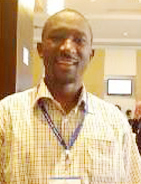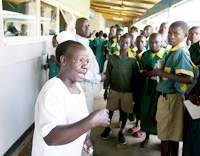
Retaining Health Workers in Rural Kenya: What We Can Learn from Other Countries
This is an excerpt from an original post on the IntraHealth International blog.
 In the northern arid lands and other remote parts of Kenya, the Capacity Kenya project has been working with the Ministry of Health to design simple packages to attract health workers and encourage them to stay. Starting with a selected list of diverse pilot sites, the project set out to design intervention packages, implement them, and systematically evaluate their impact on health worker retention over time.
In the northern arid lands and other remote parts of Kenya, the Capacity Kenya project has been working with the Ministry of Health to design simple packages to attract health workers and encourage them to stay. Starting with a selected list of diverse pilot sites, the project set out to design intervention packages, implement them, and systematically evaluate their impact on health worker retention over time.
A couple of weeks ago I attended the Second Global Forum on Human Resources for Health in Bangkok, which gave me a unique opportunity to learn about the struggles, successes, and constraints of other countries. As I listened to the experiences of others and what they see as best practices, I kept thinking about what new interventions might work best in the Kenyan context. I left Bangkok with more questions than answers, and I believe the community of practice on health worker retention will continue to face challenges as we scale up beyond controlled and localized contexts.
Retention research needed
I think we can do better and do more. Sifting through the case studies presented at the conference, I considered the areas in which we need to continue working and what kind of research is needed in health worker retention.
- We need more rigor in designing, documenting, and evaluating retention interventions.
- We need to define a common standard for a “desirable period” of retention. The opportunity costs of prolonged high-vacancy rates are not consistent across countries and contexts.
- When studies rely heavily on external resources, as is often the case, strategic and deliberate planning is needed on how to scale up and replicate positive lessons from a proliferation of pilot initiatives around retention. Sadly, few examples exist on how to mobilize broad-based funding using sector-wide approaches.
- We need studies that analyze the relative costs compared to the benefits of retention interventions in a way that can be presented to policy-makers and encourage the scale-up of successful projects in diverse contexts.
- We need studies that apply the World Health Organization’s recommendations in ways that account for local “context” and are clear in the methodology and logic behind the “bundles of interventions selected.”
- Knowing that most desirable interventions cost much more than what most crisis countries can afford, we need studies that provide more in-depth explorations of what makes successful interventions work so countries can adapt this knowledge to local contexts and local budgets.
Related items:
Capacity Kenya, an IntraHealth International-led, USAID-funded project, works with Kenya’s health care leadership to strengthen human resources for health systems of the public, faith-based, and private health sectors to ensure improved delivery to primary health care and, ultimately, to improve health outcomes of the Kenyan people. It is an associate award of the Capacity Project, the predecessor to CapacityPlus.
Photo 1 courtesy of Achim Chiaji. Photo 2 by Trevor Snapp (Nurse talks with visiting students at Friends Kaimosi Hospital, Kenya)


